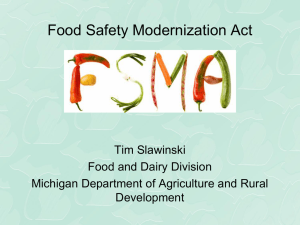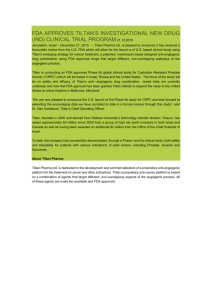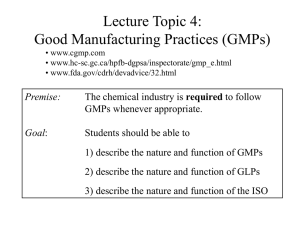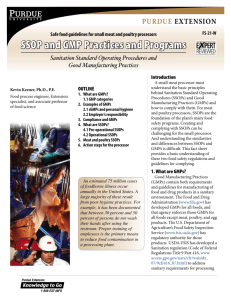Proposed Food Safety Processing Regulations
advertisement
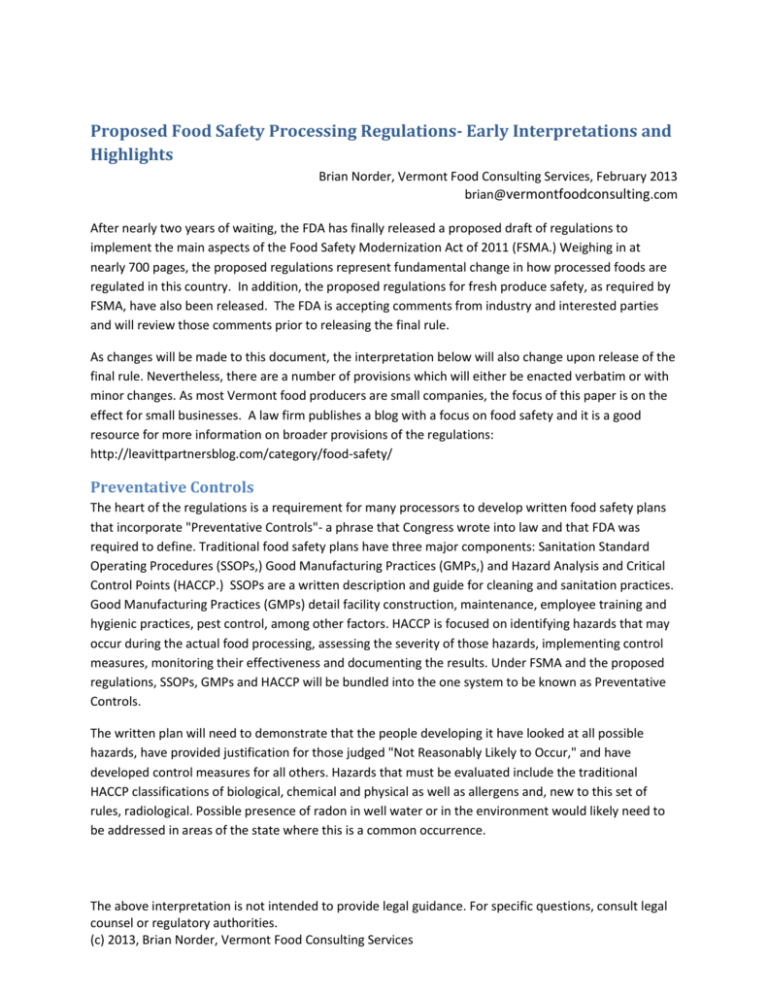
Proposed Food Safety Processing Regulations- Early Interpretations and Highlights Brian Norder, Vermont Food Consulting Services, February 2013 brian@vermontfoodconsulting.com After nearly two years of waiting, the FDA has finally released a proposed draft of regulations to implement the main aspects of the Food Safety Modernization Act of 2011 (FSMA.) Weighing in at nearly 700 pages, the proposed regulations represent fundamental change in how processed foods are regulated in this country. In addition, the proposed regulations for fresh produce safety, as required by FSMA, have also been released. The FDA is accepting comments from industry and interested parties and will review those comments prior to releasing the final rule. As changes will be made to this document, the interpretation below will also change upon release of the final rule. Nevertheless, there are a number of provisions which will either be enacted verbatim or with minor changes. As most Vermont food producers are small companies, the focus of this paper is on the effect for small businesses. A law firm publishes a blog with a focus on food safety and it is a good resource for more information on broader provisions of the regulations: http://leavittpartnersblog.com/category/food-safety/ Preventative Controls The heart of the regulations is a requirement for many processors to develop written food safety plans that incorporate "Preventative Controls"- a phrase that Congress wrote into law and that FDA was required to define. Traditional food safety plans have three major components: Sanitation Standard Operating Procedures (SSOPs,) Good Manufacturing Practices (GMPs,) and Hazard Analysis and Critical Control Points (HACCP.) SSOPs are a written description and guide for cleaning and sanitation practices. Good Manufacturing Practices (GMPs) detail facility construction, maintenance, employee training and hygienic practices, pest control, among other factors. HACCP is focused on identifying hazards that may occur during the actual food processing, assessing the severity of those hazards, implementing control measures, monitoring their effectiveness and documenting the results. Under FSMA and the proposed regulations, SSOPs, GMPs and HACCP will be bundled into the one system to be known as Preventative Controls. The written plan will need to demonstrate that the people developing it have looked at all possible hazards, have provided justification for those judged "Not Reasonably Likely to Occur," and have developed control measures for all others. Hazards that must be evaluated include the traditional HACCP classifications of biological, chemical and physical as well as allergens and, new to this set of rules, radiological. Possible presence of radon in well water or in the environment would likely need to be addressed in areas of the state where this is a common occurrence. The above interpretation is not intended to provide legal guidance. For specific questions, consult legal counsel or regulatory authorities. (c) 2013, Brian Norder, Vermont Food Consulting Services Exemptions and Effective Deadline Human nature being what it is, the first questions many producers will ask are, "Am I exempt?" and "What is my deadline?" Congress displayed some sensitivity to small producers by inserting language for exemptions which FDA is refining. FDA is proposing that "very small businesses" can claim exemption and is seeking comment about the sales volume criteria for "very small." Options under discussion are less than $250,000 per year in sales, less than $500,000 per year in sales and less than $1 million per year in sales. The final result is likely to be either the $250K or $500K definitions. The second exemption for "Qualified Facilities" is for small producers who a) food sales average less than $500,000/ year in the last three years AND b) more than half of sales are directly to consumers or restaurants located in the same state as the food is produced OR within 275 miles of where produced. Producers operating under one of these must either demonstrate that they have instituted some degree of control measures (but perhaps not a full Preventative Control plan,) or can document that they are in compliance with applicable state laws. If a producer chooses the latter exemption, then his or her label or point of sale material must list the actual name and address of the facility where the food was produced. A company claiming exemption that uses a co-packer for its products would likely need to identify that co-packer's business name and address on the label. Many issues surrounding the safety of fresh produced are covered in a separate, companion rule but farms that also engage in on-farm processing are classified as "farm mixed-type facilities." Generally, the above small business exemptions also apply to mixed-type facilities. Furthermore, the FDA proposes classifying a number of activities as low risk and also exempt from many provisions of the regulations. Common low risk activities on "farm mixed-type facilities" in Vermont are production of jams and jellies and boiling of sap for maple syrup. The law gives the FDA the power to revoke any business's exemption or low risk status in the event of a food borne disease outbreak from food produced at that facility, as result of an inspection that determines there is a significant health hazard or if an outbreak anywhere associated with a "low risk" food results in that food being re-classified as high risk. It must be noted, that these exemptions primarily eliminate the need for written food safety plans but they do not affect laws regarding food facility registration, recalls and other regulations. As proposed, the effective date for many if not most Vermont producers would be at least either 6 or 18 months after the final regulation is published, depending on business size. Companies selling to distributors, larger retailers or institutional buyers may find that these clients may require submission of a full food safety plan regardless of any exemption. Employee Training There is no doubt that the FDA will mandate improved training and documentation of that training as part of the final rule. It is evaluating comments as to whether elevated training requirements should apply to all food processors or whether to apply to the exemptions for small businesses and mixed-type facilities. The above interpretation is not intended to provide legal guidance. For specific questions, consult legal counsel or regulatory authorities. (c) 2013, Brian Norder, Vermont Food Consulting Services

